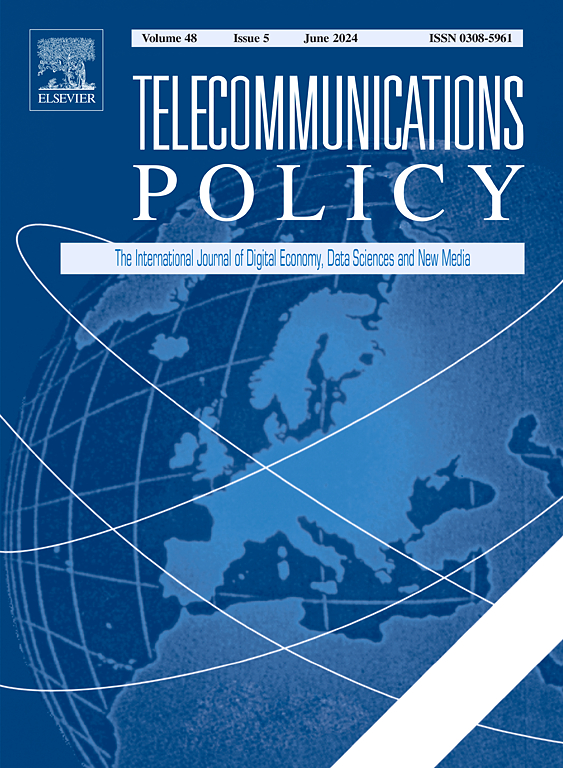Qualitative analysis of structural holes in emerging media industries: Evidence from Taiwan’s Over-The-Top Industry
IF 5.9
2区 管理学
Q1 COMMUNICATION
引用次数: 0
Abstract
This study examined the relationships, structural holes, and structural hole spanners among Taiwan’s over-the-top (OTT) operators. It explored whether Taiwan’s local OTT operators can serve as bridges or structural hole spanners within this network. Qualitative structural analysis was performed, in-depth interviews were conducted, and data were analyzed using a grounded theory approach. Five themes were identified: (1) loose networks among local Taiwanese OTT players, with Netflix as a bridge; (2) Netflix as a structural hole spanner in Taiwan’s OTT network; (3) Netflix’s advantage from being a structural hole spanner, with local players lacking a reciprocal relationship; (4) reinforced structural holes in the Taiwanese OTT industry; and (5) opportunities for local Taiwanese OTT operators to gain an advantage. The findings identified the existence of structural holes and the following four dimensions of disconnection: structural holes from a lack of global-scale capital among local players, structural holes due to an imbalance between production and sales, weakness of local platforms leading to expanded structural holes, and structural holes in the OTT industry allowing piracy actors to play bridging roles. Domestic operators lack strong platforms, market share, and scale, with most struggling to build brands, highlighting their limited key resources. Overall, domestic operators hold no significant competitive advantage. The findings pave the way for identifying strategies to improve the industry’s structure to prevent local OTT players from becoming even more marginalized.
新兴媒体产业结构漏洞的定性分析:以台湾过度产业为例
本研究探讨台湾OTT业者之间的关系、结构漏洞与结构漏洞扳手。本研究探讨台湾本地OTT营运商是否可以在这个网路中充当桥梁或结构性的“扳手”。进行定性结构分析,进行深度访谈,并使用扎根理论方法分析数据。研究发现五大主题:(1)台湾本土OTT业者网络松散,以Netflix为桥梁;(2) Netflix作为台湾OTT网络的结构性扳手;(3) Netflix的优势在于,它是一个结构性的“扳手”,与本土企业缺乏互惠关系;(4)台湾OTT产业结构漏洞强化;(5)台湾本地OTT运营商获得优势的机会。研究发现了结构性漏洞的存在和以下四个维度的脱节:结构性漏洞是由于本地参与者缺乏全球规模的资本,结构性漏洞是由于生产和销售之间的不平衡,结构性漏洞是由于本地平台的薄弱导致结构性漏洞扩大,以及OTT行业的结构性漏洞允许盗版行为者发挥桥梁作用。国内运营商缺乏强大的平台、市场份额和规模,大多数运营商都在努力打造品牌,这凸显了他们关键资源的有限性。总体而言,国内运营商没有明显的竞争优势。研究结果为确定改善行业结构的策略铺平了道路,以防止本土OTT公司变得更加边缘化。
本文章由计算机程序翻译,如有差异,请以英文原文为准。
求助全文
约1分钟内获得全文
求助全文
来源期刊

Telecommunications Policy
工程技术-电信学
CiteScore
10.80
自引率
12.50%
发文量
122
审稿时长
38 days
期刊介绍:
Telecommunications Policy is concerned with the impact of digitalization in the economy and society. The journal is multidisciplinary, encompassing conceptual, theoretical and empirical studies, quantitative as well as qualitative. The scope includes policy, regulation, and governance; big data, artificial intelligence and data science; new and traditional sectors encompassing new media and the platform economy; management, entrepreneurship, innovation and use. Contributions may explore these topics at national, regional and international levels, including issues confronting both developed and developing countries. The papers accepted by the journal meet high standards of analytical rigor and policy relevance.
 求助内容:
求助内容: 应助结果提醒方式:
应助结果提醒方式:


